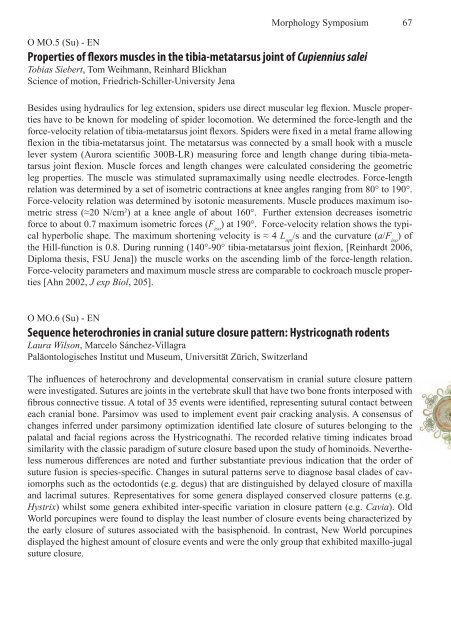Abstracts - Deutsche Zoologische Gesellschaft
Abstracts - Deutsche Zoologische Gesellschaft
Abstracts - Deutsche Zoologische Gesellschaft
You also want an ePaper? Increase the reach of your titles
YUMPU automatically turns print PDFs into web optimized ePapers that Google loves.
Morphology Symposium 67O MO.5 (Su) - ENProperties of flexors muscles in the tibia-metatarsus joint of Cupiennius saleiTobias Siebert, Tom Weihmann, Reinhard BlickhanScience of motion, Friedrich-Schiller-University JenaBesides using hydraulics for leg extension, spiders use direct muscular leg flexion. Muscle propertieshave to be known for modeling of spider locomotion. We determined the force-length and theforce-velocity relation of tibia-metatarsus joint flexors. Spiders were fixed in a metal frame allowingflexion in the tibia-metatarsus joint. The metatarsus was connected by a small hook with a musclelever system (Aurora scientific 300B-LR) measuring force and length change during tibia-metatarsusjoint flexion. Muscle forces and length changes were calculated considering the geometricleg properties. The muscle was stimulated supramaximally using needle electrodes. Force-lengthrelation was determined by a set of isometric contractions at knee angles ranging from 80° to 190°.Force-velocity relation was determined by isotonic measurements. Muscle produces maximum isometricstress (≈20 N/cm 2 ) at a knee angle of about 160°. Further extension decreases isometricforce to about 0.7 maximum isometric forces (F iso) at 190°. Force-velocity relation shows the typicalhyperbolic shape. The maximum shortening velocity is ≈ 4 L opt/s and the curvature (a/F iso) ofthe Hill-function is 0.8. During running (140°-90° tibia-metatarsus joint flexion, [Reinhardt 2006,Diploma thesis, FSU Jena]) the muscle works on the ascending limb of the force-length relation.Force-velocity parameters and maximum muscle stress are comparable to cockroach muscle properties[Ahn 2002, J exp Biol, 205].O MO.6 (Su) - ENSequence heterochronies in cranial suture closure pattern: Hystricognath rodentsLaura Wilson, Marcelo Sánchez-VillagraPaläontologisches Institut und Museum, Universität Zürich, SwitzerlandThe influences of heterochrony and developmental conservatism in cranial suture closure patternwere investigated. Sutures are joints in the vertebrate skull that have two bone fronts interposed withfibrous connective tissue. A total of 35 events were identified, representing sutural contact betweeneach cranial bone. Parsimov was used to implement event pair cracking analysis. A consensus ofchanges inferred under parsimony optimization identified late closure of sutures belonging to thepalatal and facial regions across the Hystricognathi. The recorded relative timing indicates broadsimilarity with the classic paradigm of suture closure based upon the study of hominoids. Neverthelessnumerous differences are noted and further substantiate previous indication that the order ofsuture fusion is species-specific. Changes in sutural patterns serve to diagnose basal clades of caviomorphssuch as the octodontids (e.g. degus) that are distinguished by delayed closure of maxillaand lacrimal sutures. Representatives for some genera displayed conserved closure patterns (e.g.Hystrix) whilst some genera exhibited inter-specific variation in closure pattern (e.g. Cavia). OldWorld porcupines were found to display the least number of closure events being characterized bythe early closure of sutures associated with the basisphenoid. In contrast, New World porcupinesdisplayed the highest amount of closure events and were the only group that exhibited maxillo-jugalsuture closure.

















